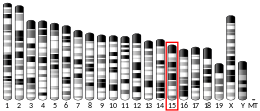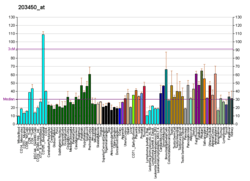CBY1
Protein chibby homolog 1 is a protein that in humans is encoded by the CBY1 gene.[5][6][7]
Function
Beta-catenin is a transcriptional activator and oncoprotein involved in the development of several cancers. The protein encoded by this gene interacts directly with the C-terminal region of beta-catenin, inhibiting oncogenic beta-catenin-mediated transcriptional activation by competing with transcription factors for binding to beta-catenin. Two transcript variants encoding different isoforms have been found for this gene.[7]
Interactions
CBY1 has been shown to interact with Beta-catenin.[8]
gollark: English *possibly* more so.
gollark: Most languages are that way.
gollark: r/weirdvaguelyracistsoundingthings
gollark: https://xkcd.com/1210
gollark: `pastebin run RM13UGFa procedure-5 install "do these command line options actually do anything" mode2`
References
- GRCh38: Ensembl release 89: ENSG00000100211 - Ensembl, May 2017
- GRCm38: Ensembl release 89: ENSMUSG00000022428 - Ensembl, May 2017
- "Human PubMed Reference:". National Center for Biotechnology Information, U.S. National Library of Medicine.
- "Mouse PubMed Reference:". National Center for Biotechnology Information, U.S. National Library of Medicine.
- Dunham I, Shimizu N, Roe BA, Chissoe S, Hunt AR, Collins JE, Bruskiewich R, Beare DM, Clamp M, Smink LJ, Ainscough R, Almeida JP, Babbage A, Bagguley C, Bailey J, Barlow K, Bates KN, Beasley O, Bird CP, Blakey S, Bridgeman AM, Buck D, Burgess J, Burrill WD, O'Brien KP (Dec 1999). "The DNA sequence of human chromosome 22". Nature. 402 (6761): 489–95. doi:10.1038/990031. PMID 10591208.
- Hidaka S, Könecke V, Osten L, Witzgall R (Aug 2004). "PIGEA-14, a novel coiled-coil protein affecting the intracellular distribution of polycystin-2". J Biol Chem. 279 (33): 35009–16. doi:10.1074/jbc.M314206200. PMID 15194699.
- "Entrez Gene: CBY1 chibby homolog 1 (Drosophila)".
- Takemaru K, Yamaguchi S, Lee YS, Zhang Y, Carthew RW, Moon RT (Apr 2003). "Chibby, a nuclear beta-catenin-associated antagonist of the Wnt/Wingless pathway". Nature. 422 (6934): 905–9. doi:10.1038/nature01570. PMID 12712206.
External links
- Human CBY1 genome location and CBY1 gene details page in the UCSC Genome Browser.
Further reading
- Wiemann S, Weil B, Wellenreuther R, Gassenhuber J, Glassl S, Ansorge W, Böcher M, Blöcker H, Bauersachs S, Blum H, Lauber J, Düsterhöft A, Beyer A, Köhrer K, Strack N, Mewes HW, Ottenwälder B, Obermaier B, Tampe J, Heubner D, Wambutt R, Korn B, Klein M, Poustka A (2001). "Toward a Catalog of Human Genes and Proteins: Sequencing and Analysis of 500 Novel Complete Protein Coding Human cDNAs". Genome Res. 11 (3): 422–35. doi:10.1101/gr.GR1547R. PMC 311072. PMID 11230166.
- Suzuki Y, Tsunoda T, Sese J, Taira H, Mizushima-Sugano J, Hata H, Ota T, Isogai T, Tanaka T, Nakamura Y, Suyama A, Sakaki Y, Morishita S, Okubo K, Sugano S (2001). "Identification and Characterization of the Potential Promoter Regions of 1031 Kinds of Human Genes". Genome Res. 11 (5): 677–84. doi:10.1101/gr.gr-1640r. PMC 311086. PMID 11337467.
- Collins JE, Goward ME, Cole CG, Smink LJ, Huckle EJ, Knowles S, Bye JM, Beare DM, Dunham I (2003). "Reevaluating Human Gene Annotation: A Second-Generation Analysis of Chromosome 22". Genome Res. 13 (1): 27–36. doi:10.1101/gr.695703. PMC 430954. PMID 12529303.
- Takemaru K, Yamaguchi S, Lee YS, Zhang Y, Carthew RW, Moon RT (2003). "Chibby, a nuclear beta-catenin-associated antagonist of the Wnt/Wingless pathway". Nature. 422 (6934): 905–9. doi:10.1038/nature01570. PMID 12712206.
- Gad S, Teboul D, Lièvre A, Goasguen N, Berger A, Beaune P, Laurent-Puig P (2004). "Is the gene encoding Chibby implicated as a tumour suppressor in colorectal cancer ?". BMC Cancer. 4: 31. doi:10.1186/1471-2407-4-31. PMC 471554. PMID 15245581.
- Collins JE, Wright CL, Edwards CA, Davis MP, Grinham JA, Cole CG, Goward ME, Aguado B, Mallya M, Mokrab Y, Huckle EJ, Beare DM, Dunham I (2005). "A genome annotation-driven approach to cloning the human ORFeome". Genome Biol. 5 (10): R84. doi:10.1186/gb-2004-5-10-r84. PMC 545604. PMID 15461802.
- Schuierer MM, Graf E, Takemaru K, Dietmaier W, Bosserhoff AK (2006). "Reduced expression of beta-catenin inhibitor Chibby in colon carcinoma cell lines". World J. Gastroenterol. 12 (10): 1529–35. PMID 16570344.
- Lim J, Hao T, Shaw C, Patel AJ, Szabó G, Rual JF, Fisk CJ, Li N, Smolyar A, Hill DE, Barabási AL, Vidal M, Zoghbi HY (2006). "A protein-protein interaction network for human inherited ataxias and disorders of Purkinje cell degeneration". Cell. 125 (4): 801–14. doi:10.1016/j.cell.2006.03.032. PMID 16713569.
- Li FQ, Singh AM, Mofunanya A, Love D, Terada N, Moon RT, Takemaru K (2007). "Chibby Promotes Adipocyte Differentiation through Inhibition of β-Catenin Signaling". Mol. Cell. Biol. 27 (12): 4347–54. doi:10.1128/MCB.01640-06. PMC 1900052. PMID 17403895.
This article is issued from Wikipedia. The text is licensed under Creative Commons - Attribution - Sharealike. Additional terms may apply for the media files.




